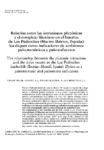Mostrar o rexistro simple do ítem
Relación entre las intrusiones plutónicas y el complejo filoniano en el batolito de Los Pedroches (Macizo Ibérico, España): los diques como indicadores de ambientes paleotectónicos y paleoesfuerzos
| dc.contributor.author | Carracedo, M. | |
| dc.contributor.author | Larrea, F. J. | |
| dc.contributor.author | Alonso Olazábal, A. | |
| dc.contributor.author | Gil Ibarguchi, José I. | |
| dc.date.accessioned | 2010-01-22T13:26:17Z | |
| dc.date.available | 2010-01-22T13:26:17Z | |
| dc.date.issued | 1997 | |
| dc.identifier.citation | Cadernos do Laboratorio Xeolóxico de Laxe, 1997, 22: 229-246 ISSN: 0213-4497 | es_ES |
| dc.identifier.issn | 0213-4497 | |
| dc.identifier.uri | http://hdl.handle.net/2183/6278 | |
| dc.description.abstract | [Abstract] The Los Pedroches batholith (Iberian Massif, SW Spain) is composed by a large biotite ±amphibole granodiorite pluton and several, smaller variable porphyritic, biotite ± cordierite granite intrusions. A dyke swarm composed esencially by trachyandesites, dacites and rhyolites cross cut the batholith. The whole set of plutonic and subvolcanic rocks define a K-rich, calc-alkaline alumino-cafemic association; only the trachyandesitic dykes ofshoshonitic affinity, get offthis trend. The dacitic and rhyolitic dykes are cogenetic with and probably comagmatic with thegranodioritic plutonand thegranitic intrusions, respectively. The trachyandesites, locallyshows sin-plutonic relations with thegranodiorite bodyand might becogenetic with mafic microgranular enclaves scattered through the granodiritic unit. The emplacement of the batholith and the dyke swarms is late-hercynian and postcollisional (300 Ma) and, was controled by a transtensional shear zone at acrustal scale. The dyke swarm use the tectonically generated fracture system during cooling and consolidation of the plutonic rocks: (i) R' type Riedel fractures for the trachyandesitic and dacitic dykes emplacement, and (ii) R type Riedel fractures for rhyolitic dykes emplacement. The arrangement ofsome dyke swarms can be use as a paleotectonic and paleostress indicators.. | |
| dc.language.iso | spa | es_ES |
| dc.publisher | Universidade da Coruña | es_ES |
| dc.subject | Dykes | es_ES |
| dc.subject | The Los Pedroches batholit | es_ES |
| dc.subject | Paleostress indicators | es_ES |
| dc.title | Relación entre las intrusiones plutónicas y el complejo filoniano en el batolito de Los Pedroches (Macizo Ibérico, España): los diques como indicadores de ambientes paleotectónicos y paleoesfuerzos | es_ES |
| dc.title.alternative | The relationship between the plutonic intrusions and the dyke swarm in the Los Pedroches batholith (Iberian Massif, Spain): Dykes as a paleotectonic and paleostress indicators | |
| dc.type | info:eu-repo/semantics/article | es_ES |
| dc.rights.access | info:eu-repo/semantics/openAccess |






